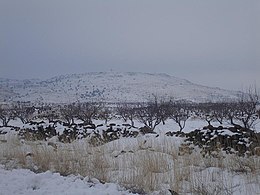|
Jabal al-Druze

Jabal al-Druze (Arabic: جبل الدروز, romanized: jabal al-durūz, lit. 'Mountain of the Druze'), is an elevated volcanic region in the As-Suwayda Governorate of southern Syria.[1] Most of the inhabitants of this region are Druze, and there are also significant Christian communities.[2][3] Safaitic inscriptions were first found in this area. The State of Jabal Druze was an autonomous area in the French Mandate for Syria and the Lebanon from 1921 to 1936.[4][5] In the past, the name Jabal al-Druze was used for a different area, located in Mount Lebanon.[citation needed] In Syria, most Druze reside in the As-Suwayda Governorate, which encompasses almost all of Jabal al-Druze. This governorate is unique in Syria as it has a Druze majority. Additionally, it has integrated Christian communities that have long coexisted harmoniously with the Druze in these mountain.[6] In the 1980s Druze made up 87.6% of the population, Christians (mostly Greek Orthodox) 11% and Sunni Muslims 2%.[7] In 2010, the As-Suwayda governorate has a population of about 375,000 inhabitants, Druze made up 90%, Christians 7% and Sunni Muslims 3%.[2] Due to low birth and high emigration rates, Christians proportion in As-Suwayda had declined.[2] Geology The Jabal al-Druze volcanic field, the southernmost in Syria, lies in the Haurun-Druze Plateau in SW Syria near the border with Jordan. The most prominent feature of this volcanic field is 1800m-high Jabal al-Druze (also known variously as Jabal ad Duruz, Djebel Al-Arab, Jabal Druze, Djebel ed Drouz). The alkaline volcanic field consists of a group of 118 basaltic volcanoes active from the lower-Pleistocene to the Holocene (2.6 million years ago to present). The large SW Plateau depression is filled by basaltic lava flows from volcanoes aligned in a NW-SE direction. This volcanic field lies within the northern part of the massive alkaline Harrat al-Sham (also known as Harrat al-Shaam) volcanic field that extends from southern Syria to Saudi Arabia.[8] Peaks
In Arabic, the word "tell" means "mound" or "hill", but in Jabal al-Druze it rather refers to a volcanic cone. See alsoReferences
|
